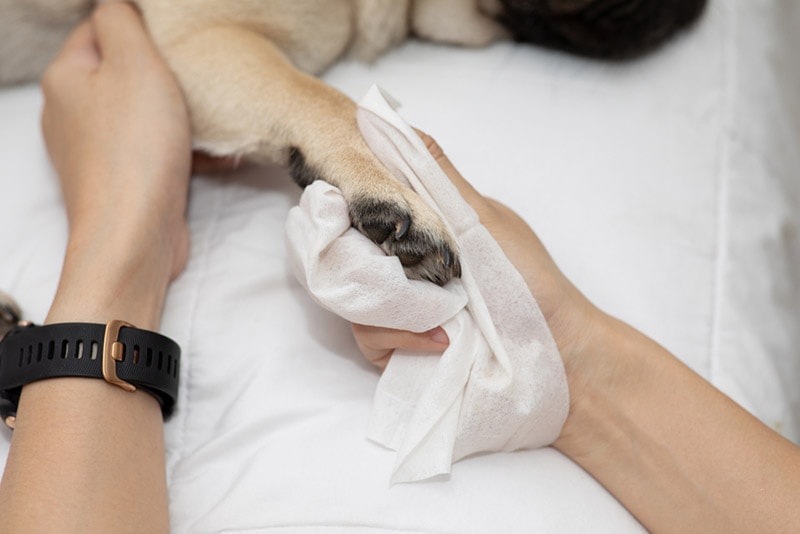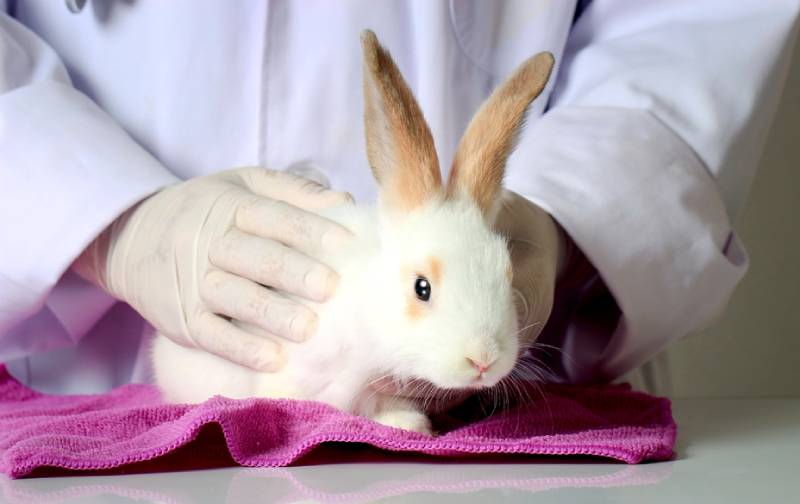Hot Spots on Dogs: Our Vet Explains Causes, Signs, & Treatments

Updated on

Click to Skip Ahead
A professor of animal dermatology once said that “skin is the bread and butter of veterinary practice,” and he was not wrong. No matter where you are in the world, there will always be dogs with skin problems, and most of those dogs will need to be seen by a vet. Dogs can be affected by fleas, allergies, mites, bacterial infections, and fungal infections; and those are just the common problems.
If you’ve had a dog with sore skin, one term you might have heard is “hot spot.” As you’ve probably already guessed, this does not mean your dog has a Wi-Fi connection, but do we actually know what this term means? If you have a thick-coated dog or one that loves to swim, if your dog enjoys a good old scratch, or if the humidity is on the rise, you might want to learn a bit more about hot spots and what they mean for your dog.
What Is a Hot Spot?
“Hot spot” is a colloquial term for a skin problem known as acute moist dermatitis, pyotraumatic dermatitis, wet eczema, or superficial focal pyoderma, depending on who you talk to. All these terms refer to the same condition, characterized by the same basic features:
- Dermatitis (inflammation of the skin)
- Pyoderma (pus in the skin)
- Moist
- Focal (localized to one area; a dog may have several hot spots at the same time)
- Pruritic (itchy)
- Often painful
- Not contagious
Hot spots are areas of the skin where the epidermis (outermost layer of the skin) has been damaged, usually by licking, scratching, or chewing, creating a raw, moist lesion. This allows the normal bacteria that live in the skin to grow and multiply, causing an infection.
Hot spots usually appear as scabby, red, itchy lesions under your dog’s fur, are often much larger than they initially seem, and can grow at an alarming rate. While they are not life threatening, they are often painful and, if left untreated, can develop secondary infections and penetrate into deeper layers of the skin.

What Causes Hot Spots?
There is a large array of things that can trigger a hot spot to form, such as:
- Insect bites/stings
- Fleas, ticks, or mites
- Allergy/atopy
- Ear infections
- Small wounds
- Skin folds
- Not drying wet fur/skin properly
- Matted or overgrown coat
- Arthritis/pain
You might be wondering how arthritis can cause a skin infection. Often when a dog is in pain, they will lick over the area or somewhere nearby as a method of self-soothing. This creates an area of skin that becomes traumatized and moist, which is the hallmark of hot spot formation.
Hot spots most commonly occur in areas where a dog has been licking, scratching, or chewing, but they can also form spontaneously in areas where moisture is trapped under the fur, particularly in skin folds and in humid conditions. They are much more common in double-coated dog breeds, as it takes longer for their skin to dry once wet.
What Are the Most Common Places for Hot Spots?
Hot spots can occur just about anywhere on the body, but there are a few locations where they appear more regularly:
- The side of the face, or around the ears and neck – This is often a result of scratching these areas, particularly if the dog has allergies or an ear infection, or because this is a “high drool” zone.
- Around the base of the tail – Dogs with fleas or problems with their anal glands will often nibble this area furiously, causing damage to the skin.
- Skin folds – The skin inside folds can become very warm and moist, leading to damaged epithelium and the spontaneous formation of hot spots.

How Are Hot Spots Diagnosed?
Your vet will usually diagnose a hot spot based on clinical history and physical examination. There are several conditions that can appear similar to hot spots, such as ringworm, canine lupus, or burns from heat or caustic chemicals, so it is important to have your dog examined by your vet before starting any treatment.
In some cases, your vet may take samples for cytology or bacterial culture to determine what type of bacteria are present.
How Are Hot Spots Treated?
There are usually two stages to treating a hot spot: treating the hot spot itself and treating the underlying cause

Treating the Hot Spot
This will depend on the location and severity of the hot spot but usually involves:
- Allowing air to get to the lesion (clipping the fur)
- Preventing further trauma (e.g., using an Elizabethan collar)
- Removing scabs and pus using an antibacterial cleaner or shampoo
- Treating the infection by applying a topical preparation to soothe the skin and/or using systemic antibiotics
Treating the Underlying Cause
This will, of course, depend on what has triggered the hot spot to form, but may involve:
- Using an ectoparasiticide to treat fleas or mites
- Treating ear infections
- Emptying anal glands
- Managing pain/arthritis
- Using antihistamines, steroids, or other allergy treatments to manage itchy skin
- Grooming or shaving the coat
- Devising ways of managing skin folds
What Can I Do to Prevent Hot Spots?
Let’s go back to the list of hot spot triggers to see which ones we can tackle to help prevent hot spots from forming.
- Insect bites/stings
- Fleas, ticks, or mites – Using ectoparasite treatments to keep these parasites away from your pet is a major step in preventing skin trauma from scratching.
- Allergy/atopy – There are many treatments for dogs suffering from chronic pruritus, such as dietary management, immunotherapy, shampoos and supplements.
- Ear infections – If your dog is shaking its head or scratching its ear, or if their ear looks red and has a discharge, make an appointment to see your vet to treat the infection before they cause too much damage by scratching.
- Small wounds
- Skin folds – If you have a dog with skin folds, it is important that they be checked and cleaned regularly. Don’t use water, as this will trap moisture in the folds; instead, use skin wipes specifically designed for the purpose.
- Not drying wet fur/skin properly – After a swim, bath, or being caught in the rain, make sure you have dried your dog thoroughly, being careful to get the undercoat dry. Drying your dogs’ coats is a great way to remove any excess moisture.
- Matted or overgrown coat – Regular grooming is an important part of caring for and bonding with your dog. It is particularly important in dogs with thick coats that are prone to knots, as a matted coat can trap moisture against the skin and hide lesions and infection from sight.
- Arthritis/pain – If you notice your dog licking a particular area a lot when there is no obvious reason, they may be feeling pain. Make an appointment with the vet for a check up, as arthritic pain is not always obvious and dogs are very good at hiding it. With so many treatments for pain and arthritis, there is no excuse for a dog to be in pain.

Can I Treat a Hot Spot at Home?
As mentioned earlier, there are a number of conditions that can mimic the appearance of hot spots, so it is always best to check with your vet. However, if your dog is prone to hot spots and you are familiar with them, there are a few things you can do at home to tame a mild hot spot:
- Prevent licking – Use a barrier like an Elizabethan or inflatable collar. Never cover the hot spot, as this will only trap heat and moisture against the skin and make things worse.
- Clip the hair – If you have hair clippers, you can trim the hair over and around the lesion to allow the air to get to it. Never use scissors or razors! Be very careful when doing anything to the hot spot, as they can be very painful, and even a placid dog could bite if they are in pain.
- Clean the hot spot with a medicated pet shampoo, or apply a specifically formulated product, such as a topical spray. Don’t use salty water, as this will just make the skin moist.
If the hot spot is not improving within a day or two, it’s time to visit the vet. If left untreated, hot spots can develop secondary, antibiotic-resistant infections, so do not delay treatment.
Final Thoughts
Hot spots are a frequently encountered skin problem seen in dogs, more common in double-coated breeds. They result from a combination of damaged or traumatized skin, moisture, and opportunistic bacterial infection. Most hot spots can be resolved using a combination of wound management, topical preparations, and systemic medications, but some may require more intensive treatment.
In many cases, hot spots are secondary to an underlying problem, most of which can be managed, treated, or prevented. Flea prevention, controlling allergies, regular grooming, and pain management are just some of the ways that we can improve our dogs’ overall health and quality of life, while at the same time reducing the risk of hot spots.
Featured Image Credit: Ashley Belle Burns, Shutterstock

















